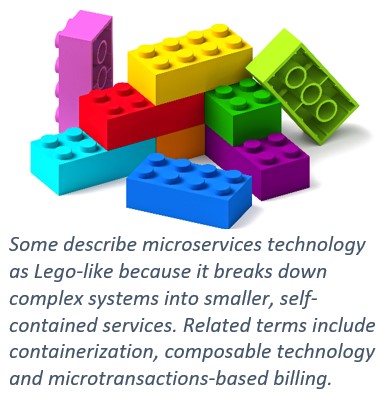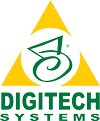A GUIDE FOR TECH SELLERS:
MICROSERVICES AND MICROTRANSACTIONS-BASED BILLING
The information management services industry is witnessing a shift toward microservices and microtransactions-based technology. As a technology seller, understanding this approach to cloud services purchasing and development is crucial. Digitech Systems is at the forefront of this move and we’ll work to keep you up to date on the latest.
Understanding Microservices
Microservices refers to the trend where businesses and organizations customize their cloud services and pay only for those capabilities that actually get used. Related terms include microservices architecture, composable technology and containerization. An example of composable technology is Digitech Systems’ new robotic process automation (RPA) that costs only pennies per hour used. Some think of individual microservices as train cars connected to a train engine (i.e., a cloud services platform.) Others see microservices as like Legos or a set of gears. For tech developers like Digitech Systems, composable technology allows a greater focus on specific areas of expertise to develop improved products at a lower cost.

How Can You as a Technology Seller Adjust and Benefit?
Microservices and microtransactions-based billing offer benefits to you as an office technology seller. The approach enables you to 1) create recurring, sticky revenue streams by developing longer-term customer relationships, 2) ensure healthy profit margins by serving each customer at scale and 3) improve the cost-effectiveness of your sales, marketing and customer support efforts by gaining greater visibility into customers’ consumption habits and making it easier to target specific products and services with the most value to consumers. Making the adjustment may require some modifications in your current business model. Here are six ways to adapt:
1. Product Offerings and Partnerships: Expand your product offerings by adding technology partners with microservices solutions to create a robust ecosystem of compatible components. Companies that adapt will stand out and attract customers looking for microservices solutions.
2. Sales and Marketing Strategies: Implement sales and marketing strategies that effectively communicate the benefits of composable technology. Highlighting the agility, scalability, and innovation potential resonates with businesses seeking to stay current with evolving digital technology.
3. Customer Engagement and Support: Engage customers in more consultative discussions. Collaborate with clients to design tailored systems from modular components. This approach addresses customers’ specific needs and fosters long-term partnerships.
4. Education and Training: Keep learning yourself and play an active role in educating your customers about the benefits, implementation, and best practices of microservices technologies. Offer training programs and resources to empower customers to make informed decisions.
5. Pricing Models: Adjust your pricing models to accommodate microtransactions-based billing that is a key aspect of microservices. Explore related models such as subscription-based models or component-based pricing.
6. Customization vs. Complexity: Strike the right balance between customization and complexity by staying flexible and making sure the process of selecting and integrating components isn’t overwhelming.
The shift to microservices presents both challenges and opportunities for technology sellers. By understanding this trend and adjusting your strategies accordingly, you can position yourself for success in this evolving market. For more information on microservices, microtransactions-based billing and related areas such as containerization, watch this brief presentation, Two Question Tuesday: Do You About Containerization Yet? - Digitech Systems, LLC.
RELATED LINKS
- Visit our Microservices and Microtransactions-based Billing webpage to learn more about the emerging shift in how technology is purchased and delivered.
- Read about the changing office technology landscape in this Workflow Magazine article,“The Flexible Future Office.”
- More cost-effective information management is coming to organizations. Read “What’s behind the shift to microservices? You, the consumer.”
- Want to see robotic process automation (RPA) in action? Check out this video demo!

Contact Info
+1 866.374.3569
Email Support
Email Sales
Daily: 8:00 am - 6:00 pm CST/CDT
Saturday & Sunday: Closed
Copyright © 2025 Digitech Systems, LLC - All Rights Reserved